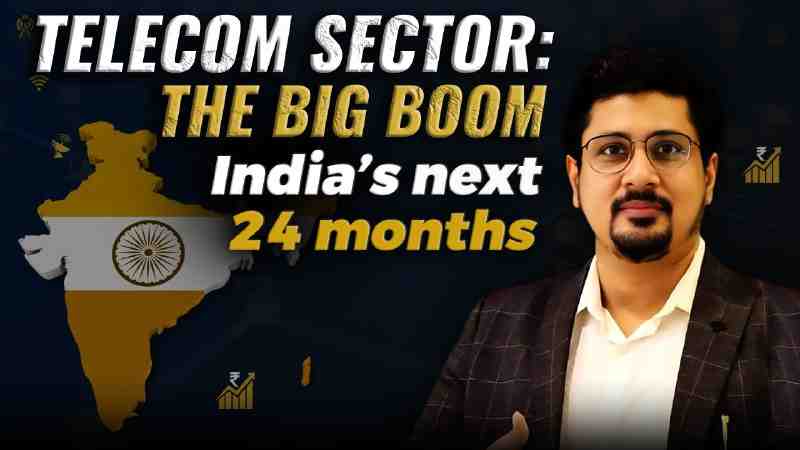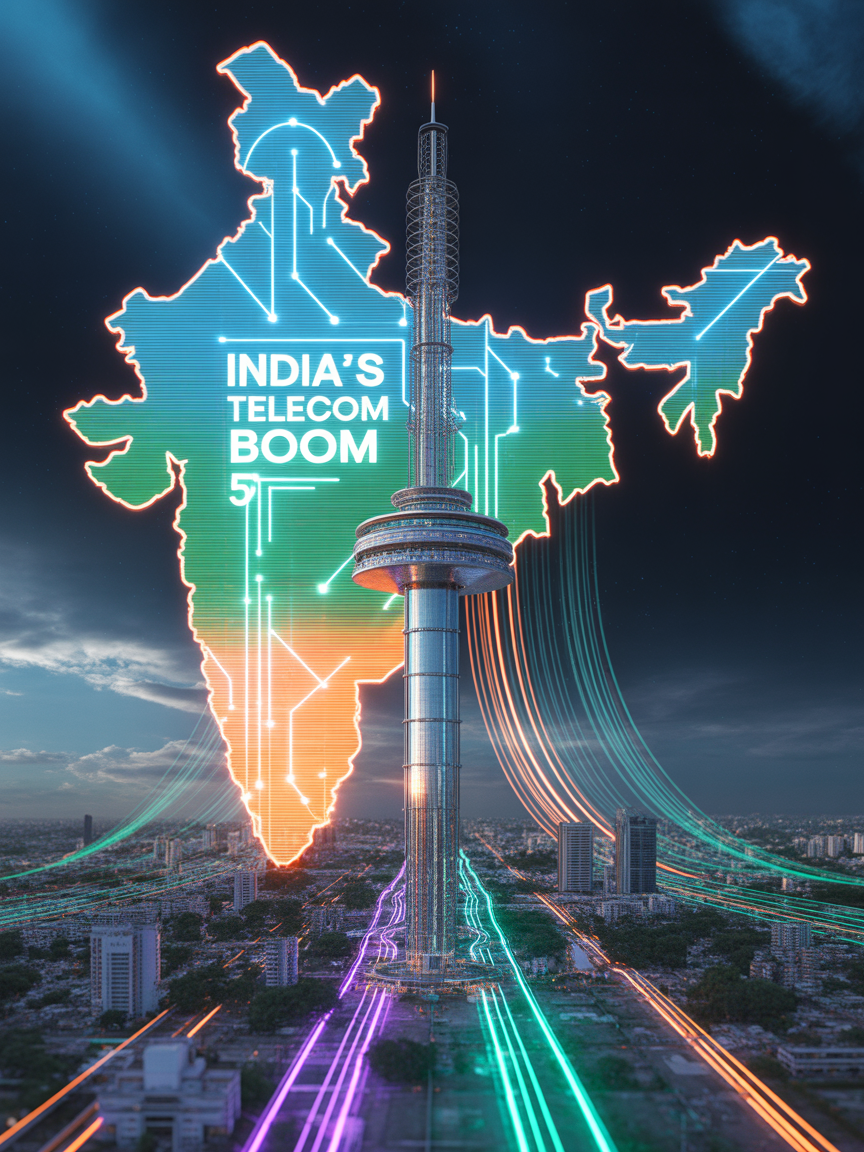
India’s Big Boom in the Telecom Sector: The Next Decade of Connectivity
01-10-2025

India is on the cusp of a transformative era in telecommunications. With over 1.1 billion mobile connections, 850+ million internet users, and the world’s cheapest mobile data rates, India is not just consuming telecom services—it is setting the stage for the next wave of global connectivity. From 5G rollouts and fiber expansion to AI-driven networks and rural inclusion, the telecom sector is poised to be the backbone of India’s digital economy.
India’s telecom story is entering a new cycle. The race for subscribers is over; now the battle is about monetization—driven by ARPU growth, 5G scale, FWA adoption, policy push, BSNL’s indigenous stack, and the satellite internet unlock. The next 24 months could redefine the sector.

01-10-2025

India`s Telecom Landscape Today-A Giant Awakens
The world`s largest democracy is experiencing an unprecedented telecommunications revolution, fundamentally transforming how 1.4 billion people connect, communicate, and conduct business.
Where We are Today: The Baseline
ARPU Rising: Airtel’s ARPU has touched 174.46 (from 149.25 last year), while prepaid ARPU is at 173.8.
Data Boom: Wireless data consumption grew +17.46% YoY, but subscriber growth is nearly flat at 1.2 billion.
Interpretation: User growth is saturated; revenue per user is the new battlefield.
Telcos no longer want more SIMs—they want more value per SIM
.png)
01-10-2025

Why This Boom Could Be Real
While 5G expansion is rapid, the real question for India`s telecom sector is how scale translates into cash flow. Two powerful monetization levers are emerging to drive this growth: Fixed Wireless Access (FWA) and Enterprise 5G.
From Users to Monetization
India’s telecom sector has moved on from the “subscriber wars.” Now it’s all about:
Tariff discipline instead of price wars
Bundle upselling (OTT, cloud, IoT)
Premium ARPU segments like postpaid, enterprise, and home broadband.
This interplay—more 5G sites leading to increased capacity, enabling more premium plans, and ultimately boosting Average Revenue Per User (ARPU)—is creating a clear path to monetization for Indian telcos.
5G, FWA, and Enterprise Opportunities:
FWA (Fixed Wireless Access): Using 5G to deliver home broadband in areas where fiber is unfeasible.
Enterprise 5G: Factories, ports, and campuses are adopting private networks for low-latency, high-reliability connectivity.
Global Outlook: FWA is projected to hit 350M connections globally by 2030, with India poised as a major contributor.
.png)
01-10-2025

Government Support & Reforms
Strategic government reforms and massive investment commitments are creating the foundation for India`s telecommunications transformation and global leadership.
India launched 5G services in October 2022, and within just two years, more than 200 million users are already on 5G networks.
Investments worth ₹2.5 lakh crore+ have been committed by telecom giants like Reliance Jio, Bharti Airtel, and Vodafone Idea to expand nationwide coverage.
5G is expected to add $450 billion to India’s GDP by 2035 through faster speeds, ultra-low latency, and enabling IoT, autonomous vehicles, AR/VR, and Industry 4.0.
Telecommunications Act 2023 :Comprehensive reform enabling flexible spectrum allocation, streamlined right of way processes, and shared infrastructure development for faster network deployment.
PLI Scheme Investment: Rs. 12,195 crore ($1.65B) Production Linked Incentive scheme specifically targeting telecom and networking product manufacturing to boost domestic capabilities.
India attracts $40 billion in telecom FDI since 2000, with 15.49% revenue growth in 2024-25 and third place globally in annual investment and market size, demonstrating strong investor confidence.
Fiberization & Rural Connectivity:
BharatNet project aims to connect 2.5 lakh gram panchayats with high-speed broadband.
Fiberization of telecom towers, currently at ~38%, is projected to reach 70% by 2030.
Bridging the rural-urban divide in internet penetration (urban: 73%, rural: 37%) is a massive opportunity.
01-10-2025

Emerging Trends Reshaping the Sector
📶 Affordable Data Revolution
India has the world’s lowest mobile data cost: ₹10–₹15 per GB compared to the global average of ₹600+.
Average data consumption: 24 GB per user/month (2025 estimate), one of the highest worldwide.
🌐 Internet of Things (IoT) and AI Networks
By 2030, India will have 2 billion+ IoT devices across smart homes, smart cities, logistics, and manufacturing.
Telecom operators are deploying AI-based network optimization for predictive maintenance and better user experience.
🛰️ Satellite Internet Revolution
Players like Starlink, Bharti-backed OneWeb, and Jio Satellite Communications are racing to provide connectivity in remote areas.
This could be a game-changer for India’s 650,000 villages, many still underserved.
💸 Fintech & Telecom Integration
Telecom companies are entering digital payments, UPI-based services, and mobile banking.
Jio and Airtel are integrating fintech, OTT, and retail ecosystems into telecom platforms, boosting ARPU (Average Revenue Per User).
01-10-2025

Market Outlook and Projections
-
Industry Size: Expected to reach $135 billion by 2030 from ~$60 billion in 2022.
-
Employment: Over 6 million direct and indirect jobs expected by 2030.
-
Capex Trends: Annual investments of $15–20 billion in networks and digital infrastructure.
-
Export Potential: India is emerging as a hub for telecom equipment exports under the PLI scheme.
01-10-2025

Challenges on the Road Ahead
High Debt Burden: Telecom operators still carry a combined debt of ₹6 lakh crore+, largely from spectrum costs.
ARPU Pressure: Despite rising data consumption, ARPU (~₹200/month) remains low compared to developed markets (~₹600–800).
Competition & Consolidation: Reliance Jio and Airtel dominate, while Vodafone Idea struggles to stay afloat.
Regulatory & Security Concerns: Issues of data privacy, 5G spectrum allocation, and Chinese equipment ban remain sensitive.
01-10-2025

Key Takeaways
The SIM race is over—monetization is king.
FWA + 5G + Satellite = the multi-leg growth stack.
Policy and indigenous tech are critical enablers.
Watch execution, ARPU, and enterprise adoption closely.
Telcos are no longer just pipes. They’re evolving into platforms—and platforms scale.
